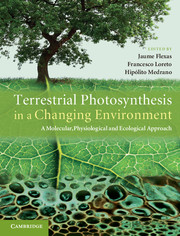 Terrestrial Photosynthesis in a Changing Environment
Terrestrial Photosynthesis in a Changing Environment Book contents
- Frontmatter
- Contents
- List of contributors
- Preface
- Acknowledgements
- List of abbreviations
- 1 Terrestrial photosynthesis in a changing environment
- Part I Photosynthesis
- Part II Measuring photosynthesis
- Part III Photosynthetic response to single environmental factors
- Part IV Photosynthesis in time
- Part V Photosynthesis in space
- 26 Whole-plant photosynthesis: potentials, limitations and physiological and structural controls
- 27 Ecophysiology of photosynthesis in the tropics
- 28 Ecophysiology of photosynthesis in desert ecosystems
- 29 Ecophysiology of photosynthesis in semi-arid environments
- 30 Ecophysiology of photosynthesis in temperate forests
- 31 Ecophysiology of photosynthesis in boreal, arctic and alpine ecosystems
- 32 Crop photosynthesis
- Part VI Photosynthesis in a global context
- References
- Index
29 - Ecophysiology of photosynthesis in semi-arid environments
Published online by Cambridge University Press: 05 March 2013
- Frontmatter
- Contents
- List of contributors
- Preface
- Acknowledgements
- List of abbreviations
- 1 Terrestrial photosynthesis in a changing environment
- Part I Photosynthesis
- Part II Measuring photosynthesis
- Part III Photosynthetic response to single environmental factors
- Part IV Photosynthesis in time
- Part V Photosynthesis in space
- 26 Whole-plant photosynthesis: potentials, limitations and physiological and structural controls
- 27 Ecophysiology of photosynthesis in the tropics
- 28 Ecophysiology of photosynthesis in desert ecosystems
- 29 Ecophysiology of photosynthesis in semi-arid environments
- 30 Ecophysiology of photosynthesis in temperate forests
- 31 Ecophysiology of photosynthesis in boreal, arctic and alpine ecosystems
- 32 Crop photosynthesis
- Part VI Photosynthesis in a global context
- References
- Index
Summary
Introduction
Arid and semi-arid environments currently cover a third of terrestrial Earth surface. By definition, ‘semi-arid’ refers to environments where insufficient water is available for vegetation growth. Semi-arid regions are characterised by being intermediates between desert (arid) and humid climates (Fig. 29.1), with an annual precipitation (250–1000 mm year–1) typically lower than the potential evapotranspiration (PET). Furthermore, precipitation is concentrated in specific periods of the year, inducing interruptions of the growing season when water availability reaches the threshold that dramatically limits ecosystem functioning. In addition to pronounced seasonality, a third component is the unpredictability of precipitation, resulting in short drought periods even during the humid season. This unpredictability also refers to high year-to-year variability, which increases with decreasing annual precipitation, often leading to alternation of dry and humid cycles lasting several years. The inter-annual variability is also mirrored in actual evapotranspiration (AET).
The availability of precipitation and the topography of the site are the major factors determining the amount of water available for plants. However, a more detailed division of semi-arid biomes should also consider other components of climate. Temperature is a major climatic element differentiating semi-arid ecosystems. Aside from water, low temperatures become a limiting factor for plant productivity and growth in the coolest semi-arid zones, whereas heat stress can limit plant production in savannas and Mediterranean environments. According to Köppen (1936) classical classification, major biomes in semi-arid climates are savannas (Aw according to Köppen), steppes (BS) and Mediterranean-type ecosystems (Cs). Oceanic and tropical influences prevent low temperatures in Mediterranean regions and especially in savannas. Steppes are characterised by continental influences with wide seasonal and daily ranges in temperature.
- Type
- Chapter
- Information
- Terrestrial Photosynthesis in a Changing EnvironmentA Molecular, Physiological, and Ecological Approach, pp. 448 - 464Publisher: Cambridge University PressPrint publication year: 2012
- 12
- Cited by


